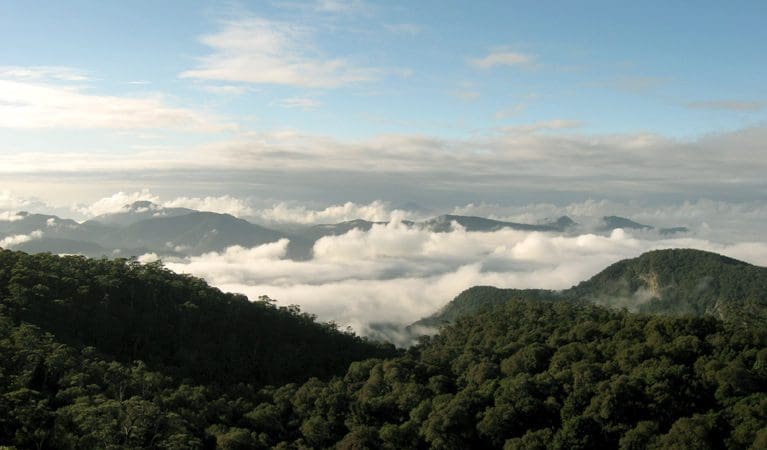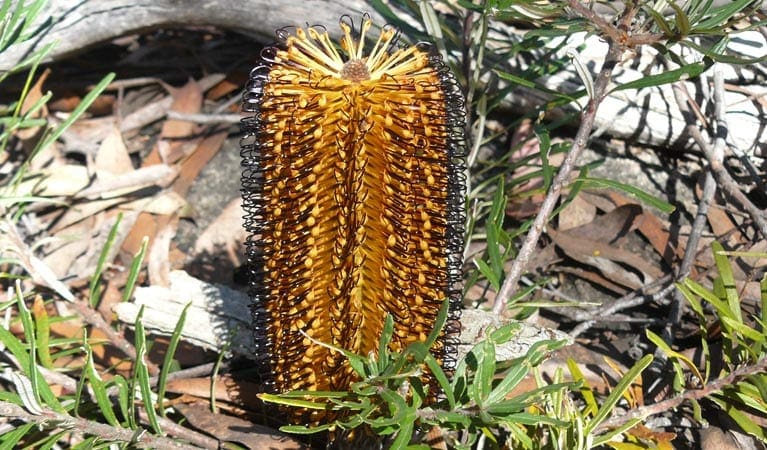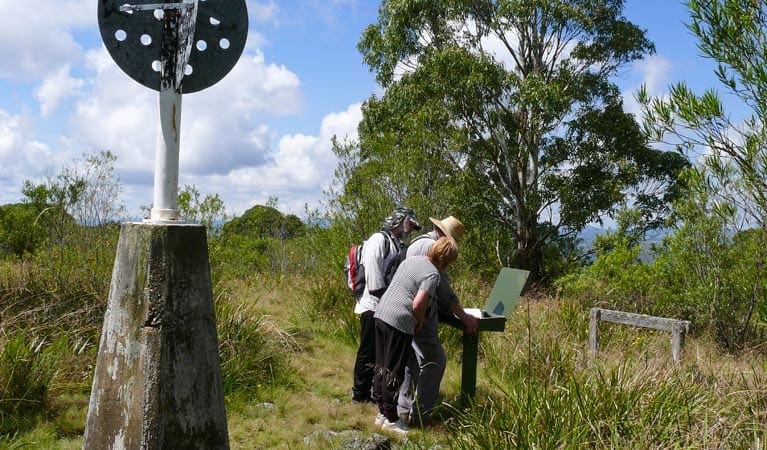Hike at a Glance
Max elevation: 0m
Min elevation: 0m
Total Ascent: 0m
Hike overview
This gorgeous and tranquil 5.7km walk (return) takes viewers down along the beautiful valley below Wrights lookout walking track past cascades and waterfalls, alongside giant king ferns and mossy boulders. Five Day Creek, along Cascades walking track, is one of the most beautiful rainforest streams in New South Wales. Visitors have described doing this walk as like being in another world, filled with vivid green moss, liverworts and lush ferns. It stands in stark contrast to the nearby dry, low heath covered, rocky outcrop of Wrights lookout. Wander slowly and find fascinating fungi along the way.
You may hear the deep calls of the brown pigeon or see flocks of white-headed or topknot pigeons searching for rainforest fruits. An enormous variety of invertebrate animals live in the park and may be encountered on this walk - the most famous of which is the living fossil velvet worm, or 'peripatus', as it's commonly known. Rather like a velvety caterpillar, it can be found in moist places under fallen timber and in sphagnum moss. It has changed little from its ancestor - one of the first creatures that moved onto land 540 million years ago.
Tips
The weather in this area can be extreme and unpredictable, so please ensure you're well-prepared for your visit.
Remember to take your binoculars if you want to bird watch
Visit NSW National Parks and Wildlife Service for more information on this trail.
The longitude and latitude of the start and end points are approximately only and should not be used for navigation purposes. Please contact me if you know the correct coordinates.
Gallery
Got some great shots from this hike? Upload your photos here to inspire others and show off the beauty of the trail!
Click to view form >>
Submitting your photos doesn’t mean you lose ownership. You can be credited for your contributions, and you can request removal at any time.
Content use
Please don’t copy GPX files or content from this site to AllTrails or other platforms. Each trail has been personally mapped, documented, and refined to support Australia’s bushwalking and hiking community. While some details come from land managers, every listing reflects significant personal effort. This is a free, community-driven initiative—your respect helps keep it that way.
Walk map and GPX file
It looks like I don’t have a GPX file for this trail yet. If you have one to share, please email it to me! I’ll verify it against official maps before adding it to help other hikers have a safer, easier experience. Thanks for contributing to a better hiking resource.
Getting there
Getting to the trailhead: New England National Park.
To Robinsons Knob trail carpark. Cascades walking track is in the Point lookout precinct of New England National Park. To get there:Turn onto Point Lookout Road from the Waterfall Way halfway between Armidale and DorrigoContinue for approximately 10kmTurn right just after the park entrance and park at the Robinsons Knob trail carpark. Park entry points Robinsons Knob trail carpark See on map Parking Parking is available at Robinsons Knob trail carpark.
Closest towns to this walk: Armidale, Dorrigo, Ebor, Guyra, Inverell, Uralla, Walcha, Wollomombi
About the region
Located in the Northern Tablelands of NSW, New England National Park is a place of spectacular beauty and pristine wilderness. Part of the Gondwana Rainforests of Australia World Heritage Area, it offers visitors an unforgettable holiday experience or a peaceful weekend getaway.
Discover the ancient world sealed in Gondwana rainforest, wander through snow gum forests dotted with crimson rosellas, and see breathtaking views from the Great Escarpment on one of the many walking tracks. Walks range from an easy 200m stroll to multi-day hikes through remote wilderness.
Experience sensational sunrises and breathtaking views stretching over forested valleys all the way to the coast from Point lookout. Pack a picnic and spend a few hours admiring the spectacular view before you.
Similar walks nearby
Looking for more walks in or near New England National Park? Try these trails with a similar difficulty grade.
Track grade
Grade 4 (Hard) - Challenging Walks for Experienced Walkers: Grade 4 on the AWTGS signifies challenging walking tracks. Bushwalking experience is recommended for these tracks, which may be long, rough, and very steep. Directional signage may be limited, requiring a good sense of navigation. These walks are suited for experienced walkers who are comfortable with steeper inclines, rougher terrain, and potentially longer distances.
Explore safe
Plan ahead and hike safely! Carry enough water, pack layers for changing conditions, and bring safety gear like a torch, PLB, and reliable communication device. Check official sources for trail updates, closures, and access requirements, and review local weather and bushfire advice. Most importantly, share your plans with someone before you go. Being prepared makes for a safer and more enjoyable hike! Stay Safe, Explore More, and Always #ExploreSafe.
Packing checklists
What you carry in your pack depends on factors like weather, terrain, and your adventure type. Not sure what to bring? My free planning, food, and packing checklists are a great starting point, covering day hikes, overnight trips, and multi-day adventures. Use them to customise your kit and always prioritise safety.
Let someone know
Before heading out, take a moment to fill out your trip intentions form. It’s a quick way to share your hike details with family or friends. If something goes wrong, they can notify emergency services, ensuring a faster response and peace of mind. Stay safe and enjoy your adventure
Suggest an edit
Spotted a change on this trail? Maybe there are new features, the route has shifted, or the trail is permanently closed. Whatever the update, I’d love your input. Your feedback helps fellow hikers stay informed and ensures that our trail info stays fresh and reliable.
Acknowledgement of Country
Trail Hiking Australia acknowledges the Traditional Owners of the lands on which we hike and pay respects to their Elders, past and present, and we acknowledge the First Nations people of other communities who may be here today.






